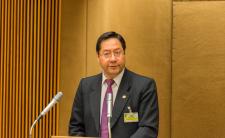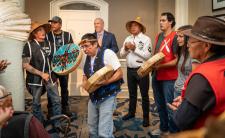The Plurinational State of Bolivia as it is officially called is a Central South American country of an estimated 9 million people bordered by Brazil, Paraguay, Argentina, Peru and Chile. It was previously part of the Inca Empire – the largest state in Pre Columbian America before European colonization and the Spanish conquest
Political system and history
Following independence from Spain in 1809, Bolivia experienced 16 years of war before the establishment of the republic, named after Simón Bolivar on August 6, 1825. Much of its subsequent history consisted of a series of nearly 200 coups and countercoups, often pitting indigenous workers, such as miners and farmers, against the wealthy descendants of the European colonialists. It has a presidential system of government with an executive headed by Evo Morales, first President o indigenous origins. Legislative power is vested in a two tier chamber and judicial power rests with a Supreme Court of Justice and other lower courts.
Constitutional history and development
The 1825 Constitution
Bolivia’s constitutional history can be traced back to the first Constituent Assembly that founded Bolivia in 1825 and wrote its first constitution. The 1825 constitution established a centralized government with executive, legislative, and judicial branches based on the United States model. The Constitution also borrowed a few premises from the French Republic, reflected in a charter that adopted liberal and representative democracy, and granting the congress autonomy and policy-making prerogatives. This constitution, however, was never adopted.
The 1826 Constitution
In November 1826, anew constitution, written by Simón Bolívar Palacio, replaced the original document. Key features of the Bolivarian constitution distinguished it from the original document in that it established a fourfold separation of powers among a lifetime presidency, an independent judiciary, a tricameral congress, and an electoral body. The constitution also extended the franchise only to property owners and persons with some remunerative business or studying the arts or science. The tricameral congress comprised the Senate and the Chamber of Tribunes, whose members had fixed terms, as well as a Chamber of Censors, whose members served for life. The Senate was, in theory, responsible for codifying laws and reorienting church and court officials. The Chamber of Tribunes possessed general legislative powers while the Chamber of Censors had oversight powers including the power to impeach members of the executive. In practice, however, the legislature's key functions were to name the president and to approve a list of successors submitted by the president. One of the lasting achievements of the Bolivarian constitution was the establishment of an executive-based system. It reflected the Spanish tradition of bureaucratic patrimonialism in which power rested with the executive as well as Simon Bolivar’s unease with mob rule. Most importantly, it also reflected his distrust for of the privileged elite who inherited Upper (Alto) Peru from Spain. Bolívar feared that rival elite factions would wage battle against each other for control over the new nation and became convinced that the best way to prevent instability and chaos was to institutionalize a strong, centralized, and lifetime presidency.
The 1831 Constitution and the 1836 Constitution of the Peru Bolivian Confederation
Due to disparities between the national aspirations of the state and its effective power over Bolivia's disparate regions and population, the Bolivarian constitution did not last long. Between 1825 and 1880, Bolivian political life was dominated by a series of quasi- military leaders, known as caudillos, which had emerged when the Spanish Empire collapsed. Within the context of economic crisis, warring caudillos, and a semifeudal social structure, constitutions and the national government became prizes to be captured by one or another caudillo.
In August 1831, a new constitution was adopted under the presidency of General Andrés de Santa Cruz y Calahumana. This constitution introduced bicameralism, dividing the body between the Chamber of Senators (Senate) and the Chamber of Deputies elected by proportional representation. It also abolished the life presidency and limited the presidential mandate to renewable four year terms. Despite these limitations, presidential power actually increased during the presidency of Santa Cruz, and the trend toward greater concentration of power in the executive continued throughout Bolivia's history.
Following the formation of the Peru Bolivian Confederation, after the a successful invasion of Peru by Bolivia in 1836, a new constitution which mostly reflected the 1831 constitution, was adopted and enforced between 1836 and 1839. With the dissolution of the confederation shortly after, executive power was reinforced and institutionalized.
The Constitutional revisions between 1839 and 1880
The caudillos dominated Bolivian political life over the next 42 years dictating new cosntitutional charters almost as regularly as changes of government occurred. Between 1839 and 1880, six constitutions were approved by the legislative power. Except for the constitution of 1839, which limited presidential power, the constitutions promulgated under José Ballivián y Segurola (1843), Manuel Isidoro Belzú Humérez (1851), José María Achá Valiente (1861), Mariano Melgarejo Valencia (1868), and Agustín Morales Hernández (1871) further concentrated power in the hands of the executive. As a rule, during this era, Congress responded to the demands of whatever caudillo was in power.
The Constitution of 1880
Following the defeat of Bolivia by Chile in the War of the Pacific from 1879 to1880, a new constitution - Bolivia’s most durable constitution was adopted. Key features of this constitution were the reinforcement and full adoption of bicameralism and the legislature becoming the centre for political debate. During this period, Bolivia achieved a functioning constitutional order complete with political parties, interest groups, and an active legislature and became the model for democracy as congressional oversight over executive behaviour were introduced and institutionalised by law in 1884.
The Constitutional Reforms of 1935 and 1947
With the overthrow of President Daniel Salamanca Urey and the global economic depression of the 1930s which heralded the end of the tin export boom which had characterised the previous years, Bolivia’s political honeymoon suddenly ceased. Between 1935 and 1952, middle-class reformist efforts converged into populist movements led by both military officers and middle-class civilian intellectuals. Under Colonel Germán Busch Becerra, a constituent assembly approved reforms in 1938 that were designed to have a lasting and profound impact on Bolivian society. Bolivia's constitution was again reformed in 1944 during the presidency of Colonel Gualberto Villarroel López , another populist reformer. Key features included voting rights for women, but only in municipal elections, and the establishment of presidential and vice presidential terms of six years without immediate reelection. In 1947 a new constitution reduced the presidential term to four years and increased the powers of the Senate following the assassination of Villarroel.
The 1952 Revolution and the 1961 Constitution
In 1952, a Bolshevik type revolution launched by the Nationalist Revolutionary Movement (Movimiento Nacionalista Revolucionario-MNR) with support from peasants, alliance of workers and some middle class defeated the anti nationalist forces of mining oligarchies. Though credited for fundamentally transforming Bolivian Society in that it gave indigenous people the right to vote, guaranteed a collective society and introduced land reforms, the revolution never fully established a new political order, and was considered incomplete. It would not be until 1961 through the adoption of a new constitution that the gains of this revolution will be institutionalised. Key in the 1961 constitution was the adoption of universal suffrage, agrarian reforms and the nationalisation of mines.
The 1967 Constitution
In 1966, General René Barrientos Ortuño overthrew the MNR heralding a new phase in Bolivian constitutional development. After calling elections in 1966 and invoking the 1947 constitution, Barrientos attempted to force through Congress a new charter. Because he sought democratic legitimacy, however, he was forced to give up his original project in favor of a constitution rooted firmly in the liberal democratic tradition that had inspired the authors of the 1880 charter. This was the 1967 constitution under which Bolivia was to remain a unitary republic that retains that character of a representative democracy. The people retained inalienable sovereign power the exercise of which was delegated the legislative, executive, and judicial powers. Cumulating executive judicial and legislative power was prohibited. Freedom of worship was recognized, though Roman Catholicism was institutionalized as the official state religion. With the overthrow of the civilian regime by General Alfredo Ovando Candia in 1970 however, this constitution was hardly enforced, neither by him nor by any of the successive military regimes that ruled Bolivia thereafter.
The 1994 Constitutional Amendments
After a period characterized by a mixture of successive civilian regimes and military coups with a checkered pattern of constitutional rule, the 1967 constitution was again substantially amended in 1994. The 1994 amendments maintained the republican character of the state and provided for balanced executive, legislative, and judicial powers. Congress retained the role to debate and approve legislation initiated by the executive. Judicial power remained in a Supreme Court and other departmental and lower courts. These amendments also extended the experiment with democratic governance introduced in previous constitutions by allowing local populations to elect their own local governments and popular assemblies
The 2006 Constitutional Process and the 2009 Constitution
In 2005, the leader of the Movement for Socialism (MAS), Evo Morales, won the general elections to become the first indigenous president of Bolivia. One of his campaign promises was to convene a new constituent assembly. The assembly was to draft a new charter that would end social injustice and inequality especially amongst the indigenous people. In August 2006, a constituent assembly was established. By 2007, it had prepared a draft constitution that was approved by the National Congress amidst political disagreements that almost derailed the process in 2008. The draft was finally approved in a Constitutional Referendum in 2009. Key features of the new constitution include recall provisions for all elected public officials, nationalization of certain economic sectors such as the gas industry, decentralization of power with four levels of autonomy (departmental, municipal, indigenous and regional), and the importance of ethnicity in Bolivia’s make up is re –emphasized through a whole chapter devoted to it.
Key timelines of the 2006 Constitutional Process
| December 2005 | Evo Morales (MAS) is elected President on a campaign platform to convene a Constituent Assembly to re write the constitution |
| July 2 2006 | Constituent Assembly is elected to collect views and prepare draft |
| December 9 2007 | Draft Constitution prepared by the constituent Assembly is approved |
| December 14 2007 | Approved draft constitution is handed over to national Congress |
| February 28 2008 | National Congress approves the draft and schedules a referendum for May 4 2008 |
| March 8 2008 | National Electoral Court suspends referendum on grounds of inadequate preparation |
| August 28 2008 | Evo Morales issues a presidential decree convoking the electorate to a referendum on December 7 2008 amidst political violence and unrest |
| October 20 2008 | Government and opposition hold talks which resulted in a compromise for the date of the referendum in 2009 |
| January 25 2009 | Draft Constitution is approved in a referendum with 64.43 percent voting yes |
| February 7 2009 | Morales promulgates the constitution into law |
| Branch | Hierarchy | Powers | Removal |
|---|



Share this article